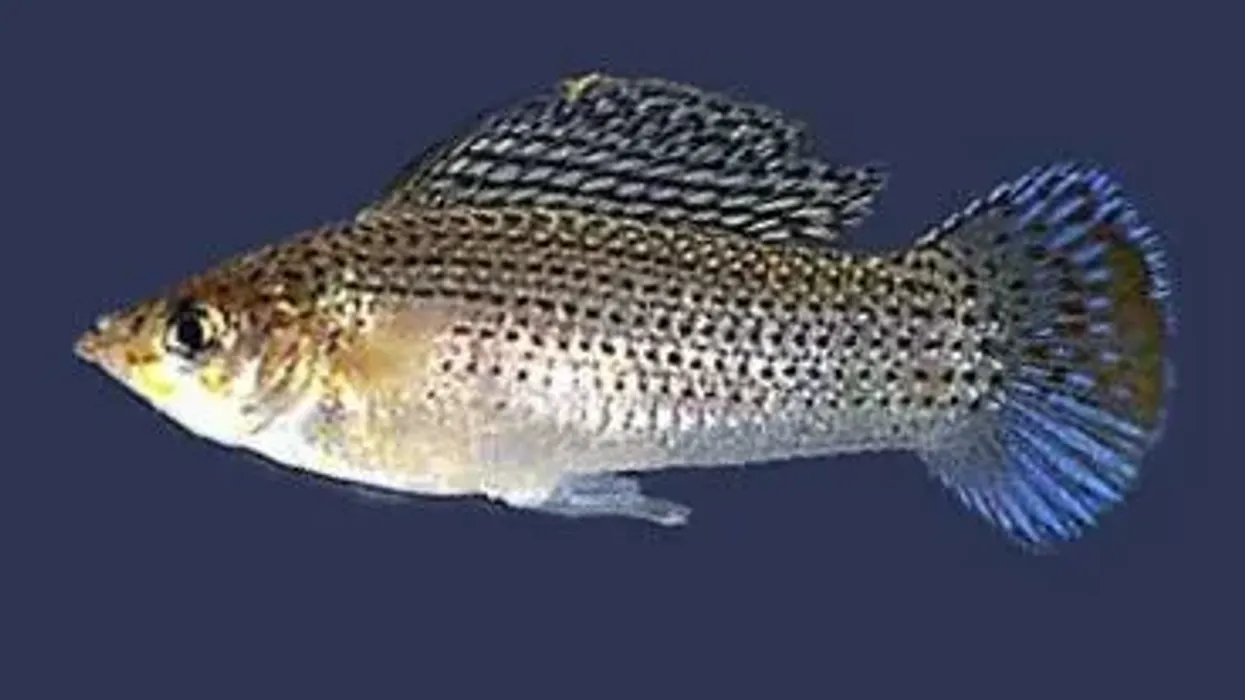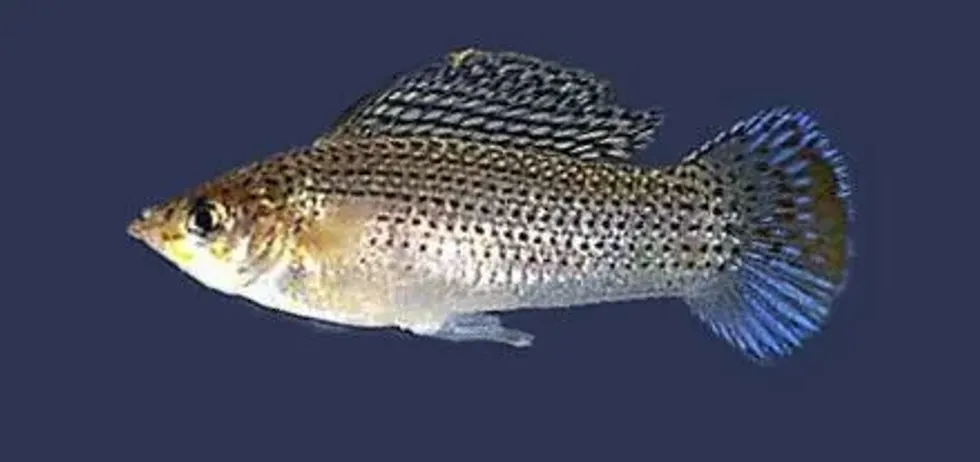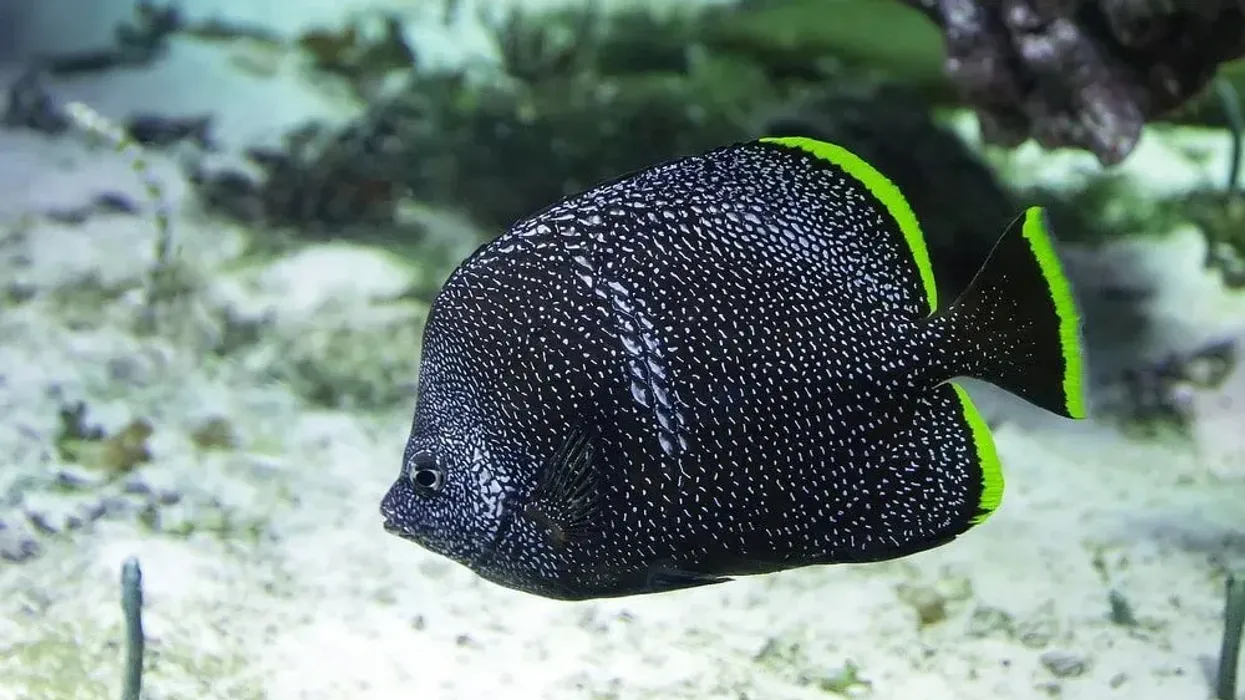The sailfin molly (Poecilia latipinna) is found from North Carolina to Texas and in the Yucatan province of Mexico. It was first observed by Charles Alexandre Lesueur in 1821 in freshwater ponds in New Orleans in Louisiana.
These fish prefer swamps, marshes, lowland streams, and estuaries. Mollies (Poecilia velifera) are common fishes in the peninsula of Florida.
These fishes were introduced in New Zealand, the western US, and Hawaii. After being introduced in California there was a decline in the population of the federally protected and endangered species of desert pupfish. The sailfin molly (Poecilia latipinna) has an oblong body with a small head and a flat dorsal body.
Their mouths are small and upturned. Their caudal peduncle is broad with a large, rounded, and black-tipped caudal fin.
The pelvic fin starts at the anterior of the dorsal fin. The dorsal fin on the males is enlarged, which gives it the name of sailfin.
The caudal fin is colorful and attracts females for mating. The females are larger and plain in color. Their body is mostly gray. Some breeding males come in greenish-blue shades.
Mollies have spots on the sides, back, and dorsal fin. These spots may blend to look like stripes. There are a variety of colors in a sailfin molly (Poecilia latipinna).
There are leucistic, melanistic, albino, and speckled forms developed by aquarists. Their diet comprises plants and algae. Here are some interesting facts about the range, distribution, habitat, food habits, and other key aspects of the sailfin molly fish. Afterward, do check our other articles on black molly and capelin fish.
Sailfin Molly Interesting Facts
What type of animal is a sailfin molly?
The sailfin molly (Poecilia latipinna) is a type of ornamental fish, known for its peaceful nature and color variations. The fish has been introduced to many oceans of the world.
What class of animal does a sailfin molly belong to?
The sailfin molly (Poecilia latipinna) belongs to the class of fish or Actinopterygii of animals. Mollies (Poecilia velifera) are small-sized fish that are found in freshwater, brackish water, and coastal areas.
How many sailfin mollies are there in the world?
The exact number of these wild fish would be difficult to tell as the fish are found in many regions. Poecilia velifera is a popular aquarium fish for private and public collections due to its various colors. It is a peaceful small fish that is attractive to look at.
Where does a sailfin molly live?
Adult mollies are found almost everywhere near the coastline. Poecilia velifera are freshwater and saltwater fish that are found in their habitats in seas surrounding North, Central, and South America.
Mollies have been introduced in places like Singapore, Japan, Taiwan, Israel, parts of East Europe, and New Zealand. These pet fishes are common fish in the state of Florida, and the Gulf of Mexico, especially in coastal parts of Yucatan.
What is a sailfin molly's habitat?
Mollies (Poecilia velifera) prefer to live in fresh, brackish, salt, and coastal waters. These pet fishes are not deepwater fishes and are found in vegetated coastal regions.
The fish is comfortable in estuaries, lakes, swamps, deltas, marshes, ponds, or even roadside ditches. You could find mollies under floating vegetation or water with a pH level of 7.5-8.5 and a comfortable temperature of 64-82 degrees Fahrenheit (17.7-27.7 degrees Celsius).
Who do sailfin mollies live with?
The sailfin molly fish does not travel in schools but in shoals. A shoal is a group of multiple fishes together for social reasons. In a school, the purpose is to travel in the same direction. The sailfin mollies are in shoals their whole lives where the male-female ratio is one to two.
How long does a sailfin molly live?
The sailfin molly fish's lifespan is three to five years in the wild. Mollies tend to live longer in captivity.
How do they reproduce?
The fertilization process is internal for sailfin molly fish. This is due to the slight modification in the anal fin of males where mollies have a structure called gonopodium.
The female gives birth to 10-140 live young ones depending on the size of the female fish. The females will store the sperm in them as per their size, and maturity even after the males have passed away.
The gestation period is for three to four weeks. Which depends on the temperature of the water. A single female fish can give birth multiple times throughout the year.
The adult population consists of more females than males as the males suffer from a higher mortality rate due to predation and diseases. The young ones are born pretty independent and the mothers do not exhibit any caring behavior.
Selective breeding to hybridize this fish is highly popular which results in a variety of colors, patterns, and tail shapes. This is one of the good reasons why this fish is so popular with aquariums.
What is their conservation status?
The conservation status of sailfin molly fish is Least Concern. Mollies are present in a wide region and their population is stable and increasing.
Sailfin Molly Fun Facts
What do sailfin mollies look like?
Mollies (genus Mollienesia) have an oblong body with a small head and a flat dorsal body. Their mouths are small and upturned. Their caudal peduncle is broad with a large, rounded, and black-tipped caudal fin.
The pelvic fin starts at the anterior of the dorsal fin. The dorsal fin on the males is enlarged which gives it the name of sailfin. The caudal fin is colorful and attracts females for mating.
The females are larger and plain in color. Their body is mostly gray, some breeding males come in greenish-blue shades. Mollies have spots on the sides, back, and dorsal fin. These spots may blend to look like stripes.
There are a variety of colors in a sailfin molly fish. There are leucistic, melanistic, albino, and speckled forms seen by aquarists. They are available in several color varieties, making them suitable for aquariums.

How cute are they?
Mollies (genus Mollienesia)are cute and colorful, known for a variety of fin shapes, colors, and patterns. These aquatic animals are highly popular in the aquarium.
How do they communicate?
Not much is known about Molly's vocal or nonvocal communications. Mollies are social fishes who can be part of shoals all their life.
How big is a sailfin molly?
The sailfin molly fish is small and grows to a length of 0.5-5 in (1.27-7.62 cm). The female mollies are slightly larger than the males.
How fast can a sailfin molly swim?
Mollies may not be fast swimmers but these community-friendly fishes are part of shoals so they would be average swimmers. Mollies are found near the coastal regions or swamps which makes them slow or medium-paced swimmers too.
How much does a sailfin molly weigh?
The mollies are lightweight fishes that are small in size. Their average weight is in the range of 0.05-0.06 oz (1.41-1.70 g).
What are the male and female names of the species?
The male Molly and female do not have a specific name. These community-friendly fishes are known as male mollies and female mollies respectively. The females are livebearers and tend to give live birth.
What would you call a baby sailfin molly?
The baby sailfin molly is called a young sailfin molly or fry. These wild fishes draw their common name from the sail-shaped fin. The adults tend to be largely females as males suffer from shimmies.
What do they eat?
This species from the genus Poecilia mostly feed on a diet of plants and algae, aquatic invertebrates, crustaceans, insects, worms, and larvae of mosquitoes. If you have them as pets you can feed them a diet of spirulina or cooked spinach as these aquatic animals are nibblers.
Fishes of this species also eat a variety of plankton as their food.
Are they dangerous?
No, this species is not at all dangerous, these are the most peaceful small fish known for their non-aggressive nature.
Would they make a good pet?
Yes, these species are very popular pet fish for public and private aquariums. Due to a variety of colors, combinations, fin shapes, and patterns, this species is very popular among aquarists to hybridize too. These fishes usually stick together most of the time and you must have them in groups of four or more.
Did you know...
These species are social creatures found in large shoals of mixed fishes. They are not deepwater fishes and can survive in oxygen-depleted habitats as they turn their mouth upwards to take in oxygen-rich surface water.
Fishes of this species are active swimmers.
Mollys are diurnal, which means this species sleeps at night and is active during the day.
On some occasions, they may prey on other mollies.
Mollys are not necessarily messy fish, but some of the hybrids are highly susceptible to diseases.
Can sailfin mollies breed with regular mollies?
Yes, sailfin mollies can breed with regular mollies. Selective breeding to hybridize this freshwater fish species is highly popular which results in a variety of colors, patterns, and tail shapes.
This is one of the good reasons why this freshwater fish is so popular with aquariums. Hybridization began in the 1920s and became a very popular feature. In the wild, it is not observed that two different varieties of mollies have been bred.
What is the rarest molly fish?
The black molly fish is the rarest molly in the world and is bred on farms in Singapore. Sailfin mollies, especially the Mexican sailfin molly or short-finned molly are extremely rare too. They are difficult to breed in an aquarium too.
Here at Kidadl, we have carefully created lots of interesting family-friendly animal facts for everyone to discover! Learn more about some other fishes from our sand dollar surprising facts and tiger oscar fun facts pages.
You can even occupy yourself at home by coloring in one of our sailfin molly coloring pages.










